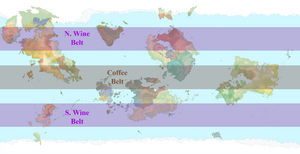Wine belt: Difference between revisions
Tag: 2017 source edit |
mNo edit summary Tags: Mobile edit Mobile web edit Advanced mobile edit |
||
| (6 intermediate revisions by 2 users not shown) | |||
| Line 1: | Line 1: | ||
{{stub}} | {{stub}} | ||
[[File: | [[File:WinebigandCoffeeBelt.png|thumb|right|Wine belt in purple]] | ||
The '''Wine Belt''' refers to the | The '''Wine Belt''' refers to the temperate regions where climatological conditions are ideal for growing wine. | ||
==Influence of climate on viticulture== | ==Influence of climate on viticulture== | ||
| Line 12: | Line 12: | ||
==Likely high output wine regions== | ==Likely high output wine regions== | ||
Every five years, the [[Royal Burgoignesc Academies|Royal Burgoignesc Viticulturist Society]] conducts a global survey of existing terrior, land under development as terrior, and currently unexploited land that can be used for viticulture, called the ''Burgoignesc Guide to Viticulture: A compendium of soil, climate, wind, and altitudinal considerations for the growing of the grape for fermenting into the intoxicating beverage''. | |||
*Central [[Canespa]]n highlands, on the western side of the slopes | *Central [[Canespa]]n highlands, on the western side of the slopes | ||
*Southeastern [[Netansett]] | *Southeastern [[Netansett]] | ||
| Line 33: | Line 35: | ||
*Western facing elevations in [[Baclovia]] | *Western facing elevations in [[Baclovia]] | ||
*All elevation in [[Mavya]] | *All elevation in [[Mavya]] | ||
*The "Wine Coast" region of [[Veraise]] | |||
==See also== | ==See also== | ||
Latest revision as of 09:11, 9 November 2024
| This article is a stub. You can help IxWiki by expanding it. |

The Wine Belt refers to the temperate regions where climatological conditions are ideal for growing wine.
Influence of climate on viticulture
Beyond establishing whether or not viticulture can even be sustained in an area, the climatic influence of a particular area goes a long way in influencing the type of grape varieties grown in a region and the type of viticultural practices that will be used. The presence of adequate sun, heat, and water are all vital to the healthy growth and development of grapevines during the growing season. Additionally, continuing research has shed more light on the influence of dormancy that occurs after harvest when the grapevine essentially shuts down and reserves its energy for the beginning of the next year's growing cycle.
In general, grapevines thrive in temperate climates which grant the vines long, warm periods during the crucial flowering, fruit set and ripening periods. The physiological processes of a lot of grapevines begin when temperatures reach around 10 °C (50 °F). Below this temperature, the vines are usually in a period of dormancy. Drastically below this temperature, such as the freezing point of 0 °C (32 °F) the vines can be damaged by frost. When the average daily temperature is between 17 and 20 °C (63 and 68 °F) the vine will begin flowering. When temperatures rise up to 27 °C (80 °F) many of the vine's physiological processes are in full stride as grape clusters begin to ripen on the vine. One of the characteristics that differentiates the various climate categories from one another is the occurrence and length of time that these optimal temperatures appear during the growing season.
In addition to temperature, the amount of rainfall (and the need for supplemental irrigation) is another defining characteristic. On average, a grapevine needs around 710 mm (28 in) of water for sustenance during the growing season, not all of which may be provided by natural rainfall. In mediterranean and many continental climates, the climate during the growing season may be quite dry and require additional irrigation. In contrast, maritime climates often suffer the opposite extreme of having too much rainfall during the growing season which poses its own viticultural hazards. Other climate factors such as wind, humidity, atmospheric pressure, sunlight as well as diurnal temperature variations—which can define different climate categories—can also have pronounced influences on the viticulture of an area.
Likely high output wine regions
Every five years, the Royal Burgoignesc Viticulturist Society conducts a global survey of existing terrior, land under development as terrior, and currently unexploited land that can be used for viticulture, called the Burgoignesc Guide to Viticulture: A compendium of soil, climate, wind, and altitudinal considerations for the growing of the grape for fermenting into the intoxicating beverage.
- Central Canespan highlands, on the western side of the slopes
- Southeastern Netansett
- Northeastern Porfiria
- Southern highlands of New Harren, on the eastern sides of the slopes
- Western Kiravian coast, on the western slopes
- Northern Kiravian coast, on the northern slopes
- Northern Cistan
- All elevations in Faneria
- All elevations in Caergwynn
- The mountains in the northern half of Fiannria, with additional irrigation
- Highland Cogenia, with additional irrigation
- Highland Calto, with additional irrigation
- Southern tip of the big Pelaxian island off the Pelaxian western coast that sort of looks like Ireland
- Southern tip of the southern island of Maristella
- Highlands on l'Iles Capræs of Port de Vent
- Highlands on the Krasoa Islands
- Southern half of Timbia, on the western slopes
- All of the elevations in Rototornicia
- All of the elevations in Tebelvonia
- Western facing elevations in Baclovia
- All elevation in Mavya
- The "Wine Coast" region of Veraise